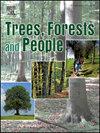将共同林与社会林业联系起来:印度尼西亚案例
IF 2.7
Q1 FORESTRY
引用次数: 0
摘要
社会林业计划旨在对印度尼西亚国有森林周围的小农户进行保护和土地再分配。然而,迄今为止的结果充其量只能说是好坏参半,分配给预定受益群体的土地面积有限。原因似乎有几个。这些问题包括:该计划的行政和管理方面受到支配、预期受益人缺乏决策参与,以及该计划分配的土地边缘化和/或远离小农户村庄。因此,小农户对这些计划并不热心,地方层面的冲突接踵而至,边缘化群体被排除在这些计划之外。我们以南苏拉威西省一个村庄中获得社区林业计划资助的两个小农户群体为例,深入探讨了小农户实际参与社会林业计划的方式和程度。我们从共同化的角度来探讨这个案例,研究当地小农群体通过共同化实践创造特定社会关系和管理机构的独特方式,使他们能够有效地从该计划中受益。我们发现,通过公有化,这些群体创建了自己的集体地方规则,并激活了非正式关系,从而能够对他们的地块进行有效的集体管理--在大多数其他类似群体中,这些地块被视为个人所有。这些成功的关键在于,他们能够利用深厚的当地知识和印尼社会林业的独特历史背景,发展和维护共同实践。该案例以一种独特的方式展示了小农户如何在正式规则的束缚下取得成功,从而实现国家计划的目标。本文章由计算机程序翻译,如有差异,请以英文原文为准。
Linking commoning with social forestry: An Indonesian case
Social forestry schemes aimed at both conservation and land redistribution for smallholders surrounding the Indonesian state forests. However, the results so far are mixed at best, with limited areas having been granted to the intended beneficiary groups. Several problems appear to be the causes. They range from the domination of administrative and managerial aspects of the scheme, lack of decision-making participation of the intended beneficiaries, to the program granting marginal land and/or located far from the smallholder villages. Consequently, smallholders are unenthusiastic about the schemes, conflict ensuing at the local level, and the marginalized groups are excluded from accessing the schemes. Focusing on a case from two smallholder groups granted with a Community Forestry scheme in a South Sulawesi village, we delve into the ways in which, and the extent to which, the smallholders are actually able to access the social forestry program. Exploring the case through the commoning perspective we examine the unique ways in which the local smallholder groups create specific social relations and governing institutions, through the practice of commoning, that enable them to effectively benefitting from the scheme. We found that through commoning the groups create their own collective local rules, as well as activating informal relations, they were able to develop effective collective management of their plots–that are treated as individual-holding in most other similar groups. These successes hinge on their ability to develop and maintain the commoning practice, utilizing deep local knowledge, and unique historical context around Indonesian social forestry. The case presents a unique way in which smallholders are muddling through the red tapes of formal rules in order to make a successful story that the state scheme intended to achieve.
求助全文
通过发布文献求助,成功后即可免费获取论文全文。
去求助
来源期刊

Trees, Forests and People
Economics, Econometrics and Finance-Economics, Econometrics and Finance (miscellaneous)
CiteScore
4.30
自引率
7.40%
发文量
172
审稿时长
56 days
 求助内容:
求助内容: 应助结果提醒方式:
应助结果提醒方式:


